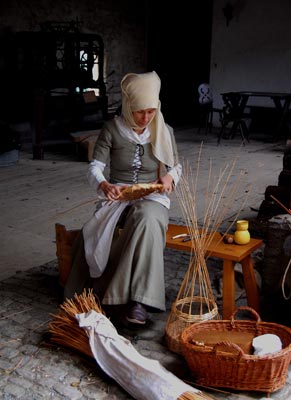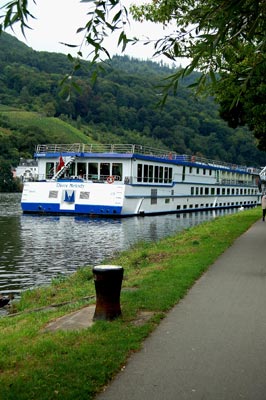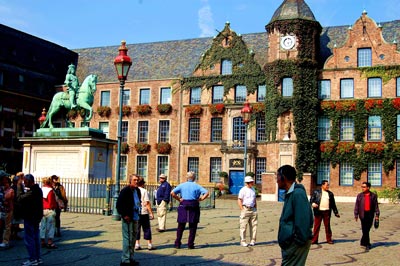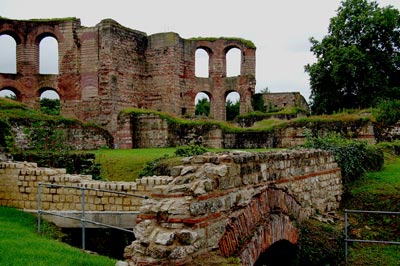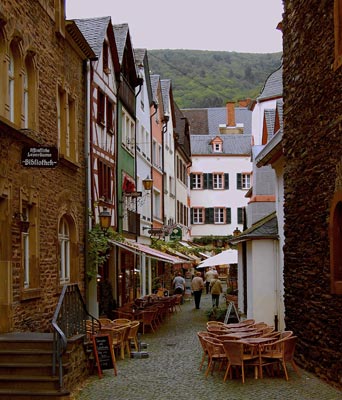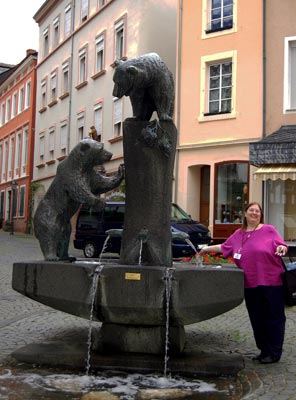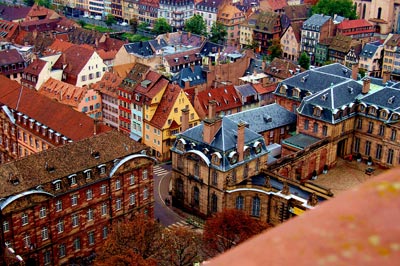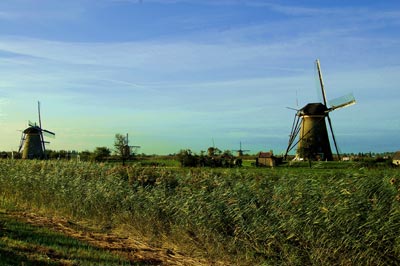Romance of the Rhine and Mosel — a beautifully orchestrated cruise aboard the River Melody
by Jane Albusche, Contributing Editor
I’d wondered why Grand Circle Travel named its European river cruise ships after composers or musical terms (Debussy, Ravel, Concerto, Harmony and so on). After the first few days aboard the M/S River Melody, the answer was obvious: our September ’07 cruise, “Romance of the Rhine & Mosel,” had a soothing yet swinging rhythm and was as fun as a German beer hall song.
It’s incredibly relaxing to have your “hotel” travel with you from stop to stop; you unpack only once and you have a convenience of choice, 24/7.
Want to go on the scheduled program? No problem; just remember to pick up your “boarding pass” at the front desk on the way out so the staff knows you’re off-ship. Want to stay in and take a nap, have a drink with a companion, go up top and sit in a deck chair to contemplate the cosmos, watch a movie in your cabin or work out (hah!) in the fitness room? You can do that, too.
Our itinerary began and ended in cosmopolitan cities: we started in Basel, Switzerland, and ended in Antwerp, Belgium. We would spend a day and a half in Strasbourg, France, and a day in the Netherlands, but the bulk of the trip (nine out of 14 touring days) was in Germany.
The character of that country was the main motif of our cruise’s “song.”
The quartet
I was fortunate to be able to travel with my husband, Alec, and especially lucky to be joined by my mother, Dola, and my Aunt Bessie (they booked only a few months before the cruise and got one of the last available cabins). Our team represented a wide range of travel experience and challenges.
Bessie and I book-ended the age range of passengers aboard. In my late forties, I think I was the youngest passenger, and at 93 Bessie beat the one other nonagenarian by a year. Bessie and Alec both have some mobility issues (arthritis), and Alec is legally blind.
An elevator between decks and a stair lift to the sun deck made everything on board easily accessible.
Overture: we begin
In Basel, the 125 passengers on our cruise got acquainted with the ship’s routine and one another. We broke into our touring “color groups,” tried out our personal audio systems, which were a great aid to hearing guide commentary, and got to know our Program Directors.
Martin Kummel, the P.D. for our 40-person “blue” group, was a cheerful, patient and knowledgeable soul. He never made questioners feel as though they had asked a silly question (and some of those questions were silly) and he had an amazing sense of awareness for the group’s energy. On the longer bus rides, he knew how to keep us entertained, what to comment on and when to stay quiet and let us regroup.
We got our first taste of his indefatigable energy and good humor on our morning walking tour of Basel. Martin led us from the medieval Marktplatz, where there is a daily market with food, produce and craft stalls, up past the red sandstone Münster, built between the 11th and late 14th centuries, and back down the hill to the modern Beyeler Foundation Museum.
We were given day passes for the public transit system and excellent maps for our free afternoon in town. At twilight, we cast off and headed upriver, passing through the first of many locks we would navigate.
Strasbourg: “C” is for canal, cathedral and chanson
On Wednesday morning our ship docked in Strasbourg and we walked a short distance to a glass-covered canal boat for our city tour.
Canals, complete with locks, wind through and around the heart of Strasbourg, the Grande Île. (The city center is a UNESCO World Heritage Site.) Our glass-enclosed boat kept us warm on this sunny but windy day and was a great way to get acquainted with the city.
Recorded commentary described the history of Strasbourg and the sights, a mixture of new (the Council of Europe headquarters and the gleaming glass ovals of the European Court of Human Rights) and old (defensive fortifications dating back to the 17th century and beautiful half-timbered houses that have been inhabited since medieval times).
The canal’s-eye view also yielded some surprises. In several places on the narrow stone or concrete footings that abutted the watercourse, we saw people camped out. At first I took them for homeless people, but their clothes and camping gear looked too good for that conclusion to seem likely. Later I asked at a tourist office near the cathedral and learned that some casual camping is allowed on the river — cheap but brrrr!
That evening, we had the first of our tour’s local entertainers perform in the lounge after dinner. Cecile sang French chansons accompanied by Lydia on the accordion. This was a terrific, high-energy show. Cecile, whose style crossed Édith Piaf with Charo, knew how to work a crowd, even one still suffering a bit from jet lag.
The morning after the show, I got up before most of Strasbourg and enjoyed walking the mostly deserted streets of the beautiful city.
At the Gothic Cathedral of Our Lady, I paid the €4.40 to walk up 660 steps to the roof. It was worth it. The view was incredible from this building, once the world’s tallest (until 1847). The carillon rang the hour as I looked out across the plains of Alsace. Inside the cathedral was a symphony of exquisite artworks and stained glass.
A fugue of fog
Mist was clinging to the lush, conifer-covered hills of the Black Forest as we drove through it by bus that afternoon. Even if Martin hadn’t told us, we’d have known when we entered Germany. Everything was so incredibly neat and tidy! Half-timbered houses with bright window boxes made one postcard-pretty picture after another, until the fog grew so thick near the top of our climb that the views were obscured.
We descended to Baden-Baden, a resort town that Martin characterized as “not typical German” and “rich but no longer hip.” It had, from the 18th to early 20th centuries, been the hangout of the (pre) jet set who came to “take the waters” and gamble in the casino. Today it’s a fondant-covered wedding cake of a city — pastel, pleasant and a bit surreal.
Well-manicured flower beds, extravagant fountains and classic Georgian architecture are pleasing eye-candy, and the Lichtentaler Allee, the long park in the center of the city, is a great place to stroll.
Barbara, our excellent local guide, took us past the Theater, the Staatliche Kunsthalle and the modern, box-like Frieder Burda Collection gallery to the sumptuous outer lobby of the Casino (gambling had started for the day and we weren’t dressed nearly elegantly enough to go in).
We continued to the Trinkhalle’s Pump Room, with pretty paintings of Germanic legends in pastiche Pre-Raphaelite style, where we tasted the mineral waters. Well, I’ve had worse; it pretty much tasted like slightly salty bathwater.
In Baden-Baden, Mom and Bessie encountered what unfortunately became a bit of a trend. Bessie’s back had begun to give her some problems, and she knew she wouldn’t be able to keep up with the brisk pace of our city tour. Mom decided they’d go on their own and meet up with the group back at the bus.
Our city guides, of course, had to keep to their schedules and couldn’t assist Mom with her questions of where, in a short walking distance, they might want to go for a few hours. The Program Directors were on a break and evidently didn’t want to take the time, or didn’t know how, to tailor suggestions for people unable to do the group activity.
Fortunately, Mom had been in Baden-Baden years before and found a good route to the sights, as well as a terrific hotel in which to relax over a sherry. Comparing our pictures that evening, we realized we’d luckily all seen the same highlights and had all managed to have a fun day.
Speyer was a different Germany altogether from frivolous Baden-Baden. The landscaping of its park, as well as its architecture, was rectangular, symmetrical and orderly.
Bells rang the hour as Alec and I walked through the park to Speyer’s Romanesque Cathedral of St. Mary & St. Stephen. The cathedral itself is a working church. Somber and lovely, it’s undergoing an intensive restoration project that will, among other things, eventually replace the stained-glass windows that were destroyed in the Second World War.
Just a few hours later we set off for one of the highlights of a Grand Circle tour, the home-hosted visit. This chance to spend some time with local people was part of the educational aspect of the trip, and we enjoyed it very much.
Just the drive out to the suburb near Speyer was instructive; it’s nice to know that not every inch of Germany is impossibly picturesque! Away from the river, they’ve got their highways and chain stores, too.
Another nice thing about these home visits is that they were done in small groups of eight, so when all the ship’s passengers came back together later we had a wide variety of experiences to share.
My mother and Bessie visited the home of a young mother who had a business as a feng shui practitioner and whose 12-year-old daughter played her flute with great expertise for the group.
The group Alec and I were in visited an older woman who had been in business and education and now had a tutoring/translation business of her own that she ran with her husband. Talking a mile a minute, Gisella served up delicious homemade cake and told us about life in Germany.
The final event of the day was a visit to the Children’s Circus Bellissima Polaris, an after-school program (partly supported by the Grand Circle Foundation) in which at-risk children learn a variety of circus skills and perform them. We were delighted by the 2- to 5-year-old tumblers and the teens who rode unicycles and performed tricky-looking acts of balancing and juggling.
Castles, castles and more castles
The next morning we sailed up the magical Rhine Valley, birthplace of Germanic legends. High, rocky ridges enclosed the river gorge, and steeply terraced fields of grapevines grew on the sunny slopes.
Towns, each more picturesque than the last, greeted us around each bend of the shallow river, and, more closely grouped than you can imagine, a chorus of castles of all periods and states of repair stood sentinel on one hilltop after another. All were, to some degree, in ruins, destroyed by Louis XIV on his army’s push through the Rhine Valley during the late 17th century.
That factoid along with a terrific running commentary during the morning’s cruise were provided over loudspeakers that could be heard by passengers watching in the comfort of the lounge and, for us hardier (more foolish) sorts, up on deck.
That afternoon I took an optional tour ($50) to the one castle left intact by Louis’ rampage. Marksburg Castle, built in the 13th century, is a wonderful example of a true defensive citadel. It’s an amazing edifice, but visitors should be surefooted; the stone floors are uneven and very steeply pitched in places.
By chance, our tour coincided with the castle’s hosting of a German medieval re-creation group, “1479.” These history buffs were garbed in period clothes and had set up their crafts in the castle, giving demonstrations of authentic cooking, woodworking, calligraphy, needlework, weaving and smithing. Cannons were set off every hour by medieval gunners. The 1479 members were delighted to share what they knew.
The next day we visited a much less “serious” castle, Reichsburg, built on the ruins of the 11th-century Cochem Castle by Louis Ravené, a wealthy merchant. Construction began in 1868 on what would become the Ravené family summer home. Completely furnished with the accoutrements of an elegant upper-middle class Victorian-era German, it was a fun place to roam.
Wine region
Although the Rhine and Mosel share some characteristics — both are great wine-grape growing regions and both are lined with small towns with similar architectural styles — the difference between them is like that of opera and folk music. The Rhine is more dramatic, showy and formal; the Mosel is warmer, simpler and homier, a place where many Germans go on camping vacations and where the pace is kick-back casual.
Many of the towns are actually “sister towns,” one on each side of the river. We had three nights on the Mosel: one in Bernkastel-Kues, one in Trier and one in Traben-Trarbach.
Bernkastel’s symbol is the bear, and bronze bears sport playfully in one of the town’s fountains. The narrow streets are lined with a mixture of medieval and Renaissance houses (this blend was also true of Trier), but in Bernkastel I saw a first: many half-timbered houses had lines of calligraphy painted on each story’s eaves. Martin translated one of them for us, a saying about the joys of drinking wine — well-suited for a town that produces what is regarded by many as the best white wine in the world: Berncasteler Doctor.
Trier
I’d read so much about the antiquity of Trier, the oldest city in Germany, that somehow I’d forgotten it has a present. I was expecting something more somber and stony than the gay, colorful, bustling town I found, one which smelled like the waffle cones everyone was eating their ice cream from.
The Romans established a city there in 17 B.C., and its Imperial Baths and Porta Nigra (Black Gate) are incredible to behold. As we passed under the Porta Nigra, we saw a toga-clad actor declaiming to a group of schoolchildren.
This was the first place we’d been on the tour where there were crowds of tourists, and it unfortunately was also the place with the least effective city guide of the trip. Hannalore was brilliant at history but hopeless at group management.
Our audio systems, which weren’t effective at distances of more than 40 feet and didn’t broadcast through stone walls, were no match for her lightning-speed attack of the catacombs under the Imperial Baths. I was really concerned I’d get lost, trailing behind her in the dim, twisty stone corridors and cut off from her narration.
Back on the surface, where we were only one of many tour groups, it was difficult to keep track of her (she was short and didn’t have a flag or anything to help us see her in a crowd). At one bathroom stop, she actually asked us, “Is everyone here now?” and when told, “No, some aren’t here yet,” she cheerfully chirped, “Good, then we go on!”
Fortunately, the itinerary once again included plenty of free time, and Alec and I greatly enjoyed our good fortune when we entered the 12th-century St. Matthias Basilika just in time to hear the organist rehearsing.
On the way back to the bus, several members of our group ran into Martin bearing an armful of red roses, and we good-naturedly kidded him about who his mystery girlfriend might be. Imagine our surprise, later that day, when we saw the flowers set up in the ship’s lobby with a placard simply saying “9-11.” I was not the only vacationer who’d forgotten what day it was, but the crew of the Melody had not.
That evening, we were incredibly touched when the Captain and the Program Directors, dressed in their formal best, read a poem and led us in a moment of silence to honor the memory of that day.
Upper Rhine
Back on the Rhine, the remainder of our travel would be through a wider, more industrialized river. It was still beautiful, but because this part of Germany was so thoroughly bombed during World War II, the cities we visited, Düsseldorf and Bonn, are almost completely new, rebuilt after 1945.
It was great to be in Düsseldorf on a Friday. Working hours ended for the week at noon, Martin explained, and the city was filled with people enjoying beer, seafood and bonhomie in the sidewalk cafés or strolling the shopping streets.
Although the die-hard shoppers on the cruise had a bit of a walk to get to spend their weak dollars in the fashionable Königsalle (about a mile from where we docked), within a 5-minute walk from the Melody were three terrific museums, all in a row, and an excellent restaurant.
We had time only to admire from the outside the Stadt Museum (tracing history of the economic development of the region) and the Hetjes Museum (with 2,000 pieces of ceramic and porcelain, some of it going back to 6,000 B.C.). Alec and I spent our time in the Filmmuseum (Schulstraße 4; phone 0211 89 92232 or visit, in German, www.duesseldorf.de/kultur/filmmuseum), a wonderfully designed 4-story space where interactive displays tell the story (in English and German) of cinema and its elements, from script to score to special effects.
Germany was a rich source of talent for Hollywood and has had a thriving film industry of its own since the silent-film days, and we enjoyed seeing some video clips of classic stars and movies we’d never heard of. Cameras, lighting equipment, costumes and gorgeous graphics were well displayed. (Open 11-5 Tuesday, Thursday-Sunday and 11-9 Wednesday; €3 adult.)
At Brauerei Zum Schiffchen (Hafenstraße 5; phone 0211 13 24 21 or visit, in German, www.brauerei-zum-schiffchen.de) Martin bought his “blues” a round of the city’s famous dark beer. Mom, who’d visited the place on an earlier trip, says Zum Schiffchen has excellent food as well, but we had to take her word for it; the meals on the ship were so good, none of us could bear to dine on shore.
That was one thing we all could agree on: the chefs aboard the Melody were simply incredible. Regional produce, exquisite preparation and a wise choice of seasonings made each meal better than the last, and the “food TV” channel (our room televisions had the day’s menus on one channel) was “must-see TV,” for me. Desserts, especially, were to die for.
The one thing I would have done differently is let the kitchen know that Alec doesn’t eat beef or pork. There were fish and vegetarian choices daily, but they didn’t offer much variety. Later I met travelers who had special dietary needs and they told me the kitchen accommodated them beautifully.
The ship had two crews on board: the sailing crew, under command of Captain Jürgen Luderer, and the hospitality staff, under Katya Fisher. Katya was quick to supply any service or answer any question with competence and a smile, and her team provided us with a level of service I could happily become accustomed to. Not only were our needs and whims provided for, they often were anticipated and with a cheerful, wholly sincere generosity.
Water music
The landscape lining the river flattened out as we cruised north into the Netherlands. In the Netherlands, it’s all about water: where it shouldn’t be, how to move it where it belongs and the never-ending battle to keep the hard-won land from being washed away.
In Kinderdijk we boarded a cute little teak boat to cruise the weteringen (canals) past the 19 windmills that make this town a World Heritage Site. There are four types of windmills, and although the oldest were built in 1738, they are working windmills and are still used in times of extreme need.
Netherlanders who wish to live in a windmill have to be able to pay for the maintenance of it and be ready to operate it if storm conditions require, which they did just a month before our visit.
We enjoyed the chance to climb through the one windmill that is preserved in its historical state (not occupied) and talk to one of the two full-time carpenters who work year-round to keep the windmills in working trim.
That afternoon, Alec and I took an optional trip to the Delta Works storm surge barrier. This massive marvel of engineering, part of a project the Dutch inaugurated after the devastating floods of 1953 when 1,835 lives were lost, is so effective the project’s hydraulic engineers have been asked to consult in the rebuilding of flood-control projects in New Orleans.
While we took this tour, the ship was docked in Willemstad. The usual “port talk” the night before which described the following day’s activities and options had failed to mention that a festival was taking place in Willemstad only a hundred yards or so from the ship. Not realizing such a short walk would take them to this fun afternoon, my Mom and Bessie missed seeing the town and were very disappointed to find out later how easy it would have been to get there.
It was a rare glitch in what was otherwise a well-run, delightful journey.
Jane was a guest of Grand Circle Travel (Boston, MA; 800/959-0405, www.gct.com), which also provided 50% of Alec’s trip. Bessie and Dola paid full fare, $4,295 each, which included airfare from San Francisco.


